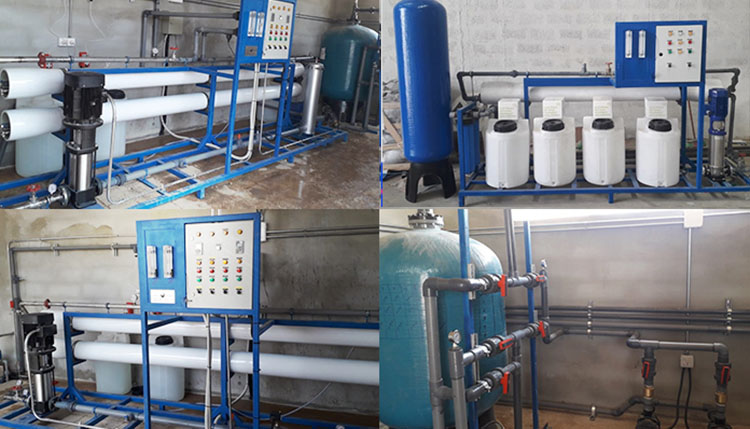
What is reverse osmosis technology?
One of the important questions to be aware of. What is reverse osmosis technology, as it is an important modern technology in the water treatment industry? Especially since it works with the lowest power requirements, some of the highest utilization rates, and some of the best filtration rates on the market.
Definition of reverse osmosis in general
It is a retrograde osmosis process. Osmosis is the passage of water through a protein membrane (such as our skin, or inside a plant cell) to balance the concentration of molecules dissolved in the water. A protein-membrane allows water to pass through, but molecules larger than water (things like minerals, salts, and bacteria) cannot. The water flows back and forth until the concentration is equal on both sides of the membrane, and an equilibrium is formed.
Definition of reverse osmosis water treatment
Let’s apply this knowledge to water purification. We want to drink water from a lake or stream, but it’s too high in contaminants like salt, minerals, and bacteria, making it undrinkable. By applying pressure to the water as it passes through the membrane, the water can be forced away from the membrane rather than trying to form a natural equilibrium. This movement against the flow is where the “reverse” in “reverse osmosis” comes from. A pump will work well for this process. The water is forced through the membrane, which acts similar to an ultrafine particulate filter, and prevents the vast majority of pollutants from entering.
As a purification process, it has a number of advantages in water treatment. TFC membranes can typically remove between 96 and 99% of most contaminants, including salts, metals, dyes, particles, bacteria, and hazardous metals. Because of the way reverse osmosis works, however, you can never remove all of the contaminants as you may need to disinfect at a fraction of a percentage, but the contaminant cannot really be removed by reverse osmosis. Treatment systems also require a high-quality pump, because the filtration rate depends primarily on the pressure applied to the membrane. However, smaller units have smaller percentages of permeability (clean and purified product) for wastewater. This makes media filtration or traditional filtration more effective at smaller scales (housing units).
Components of a reverse osmosis water treatment plant
Dosing regimen before chlorination
If the feed water contains traces of heavy metals or is contaminated, it is recommended that a certain dose of chlorine be used to change the dissolved heavy metals into physical form, and the media filter will be able to filter out most of it.
Raw water storage tank
Although some RO systems can draw water directly from a well or feed pipe, most systems start with a large tank that stores the contaminated water. Not having enough feed water can damage the pump, so having a large storage tank for your intake water is an easy way to make sure your pump lasts as long as possible.
Feedwater pump
A commercial or industrial pump provides the initial pressure to the processing system. This motor usually provides enough water pressure to pass any pretreatment as well as reverse osmosis membranes, but if not, a booster pump down the line may be necessary.
Multi-layer filter or media filter
There are some things that membranes cannot disinfect. Nitrates, a common pollutant found in fertilizers and animal waste, are a good example of molecules that dissolve well in water to reverse osmosis. Things like bad odor usually aren’t prevented by reverse osmosis, either. A multi-layer filter can be filled with media that specifically targets things your RO system can’t capture. If you need to get rid of these contaminants, multi-layer filtration is a must.
Activated carbon filter
Activated carbon filters are a good solution for reducing bad organic taste, odor, and chlorine from water.
Automatic water purifier
Automatic water softeners are designed to remove water hardness, calcium, and magnesium ions, for small reverse osmosis systems, we usually recommend water softening instead of anti-cancer chemical dosing.
Reverse osmosis technology
We finally have our reverse osmosis system. If a booster pump is necessary, this will usually be before this step. A reverse osmosis system can produce up to one million gallons of product water per day, as well as a large amount of waste. Wastewater can usually be disposed of down the drain.
Produced water tank
The treated water from the RO water purification system usually goes to a large tank, where it is held for use. If it doesn’t, you’ll need to turn the system on in order to get freshwater, which can be inconvenient. Sometimes, an RO water treatment system pumps water directly into a well or aquifer to recharge it instead of using it in many of the industries or normal applications in which it is used.
Chlorine for storage
If the permeate water is intended to be stored for more than one day, it is highly recommended to dose some chlorine to keep the water clean and uncontaminated.
Water pump processor (repressurized)
This pump pumps treated water to the ends of use.
UV water sterilization
The UV sterilizer is placed after the storage tank and as a final sterilizer. Most of the time, we either use post chlorine as a disinfecting agent or sterilize with ultraviolet light.
What are the basic components of reverse osmosis technology?
The reverse osmosis system consists of five basic parts:
Pressure vessels and membranes
Obviously, a reverse osmosis system will not stray too far from the membrane elements. The proteins that make up the membrane elements differ depending on the type and amount of water and end with purity. There are saltwater, seawater, extreme hospital-level disinfection, and membranes designed to remove specific contaminants to name a few. If there is a need for water treatment, you can be sure that there is definitely a membrane element for this. The size of the task (municipal, commercial or industrial) determines the size and number of membranes in the system. There can be anywhere from one and a half-inch membranes (as in an under-sink reverse osmosis system) to hundreds of eight-inch membranes all working together (a typical reverse osmosis plant).
Cartridge filter
Most reverse osmosis systems come with a cartridge filter to ensure that there are no particles large enough to damage membranes anywhere near them. This cartridge is usually a five-micron polypropylene filter but can vary upon request. The cartridge comes in durable housing that can handle pressure from the main feed or booster pumps.
High pressure reverse osmosis pump
Without a high-quality pump, the rejection rate of reverse osmosis technology is not viable in most commercial or industrial environments. It is essential for the system to ensure that the pump is properly matched to the quantity and size of the membrane. Typically, the higher the power of the suction pump, the better the rejection and recovery rates for permeability.
Control Board
Finally, the reverse osmosis system must be controlled by a human operator.
Reverse osmosis systems can have a number of other components built-in or on them as additional components as well. It can be fully integrated into a container system desalination by RO system is always on its way. There are a number of add-ons that can be attached to the RO system as well, to perform tasks such as membrane cleaning, pretreatment, chemical dosing, and a number of other functions as necessary.
To learn more about how reverse osmosis filters work, read this article.
What types of commercial/industrial applications does reverse osmosis technology serve?
If water treatment is required, a reverse osmosis system will likely do the trick. There is a wide range of industries that benefit from the presence of high purity water, in addition to a large number of applications that require water treatment. With so much water required, a reverse osmosis system is often the ideal economical solution, requiring less energy than most large-scale treatment methods. Since it consumes less energy, a reverse osmosis system is an environmentally friendly solution as well.
- Boiler water treatment
- Food and Beverage Services
- Industrial wastewater purification
- Hotels and resorts
- Making ice
- Cars washing
- Manufacture of pure ethanol
- Dairy industry
- The pharmaceutical industry
- Water filling
- Hospitals
- Farming
What types of water sources does reverse osmosis treat?
Reverse osmosis is the ideal water treatment solution for most types of water. In general, all major water sources can be divided from a treatment point of view into three main categories: tap water, also known as municipal sources, groundwater, and saline water. The biggest difference between these three types is the total dissolved solids (TDS) content of each type. As a general rule, the dissolved solids in drinking water should not be less than 1,000 parts per million.
Municipal Resources
Tap water usually comes through a pre-existing infrastructure such as a city pipe or dam system. Reverse osmosis is often used in a tap water environment to reduce hardness, or debris accumulating in water from traveling in metal pipes. Dissolved solids are often a target of water purification in tap water systems. This type of reverse osmosis system is ideal in places such as power plants, pharmaceuticals, laboratories, and hospitals, where the degree of water purity is critical to the industry. Tap water usually has a TDS of fewer than 1,000 parts per million.
Underground water
Underground reservoirs are often brackish or brackish, meaning they contain large amounts of salt, but not enough to be saltwater. Groundwater reverse osmosis is very common, and it is one of the best uses of a reverse osmosis system to date. It is often purified for the agricultural industry, mining industry, and residential uses. Groundwater is a distinct target for the bottling industry since unique mineral compositions often have an attractive taste. Saltwater usually has a TDS of 5,000 ppm or less, but can come in concentrations as high as 12,000 ppm.
Saltwater
Reverse osmosis for saltwater (sometimes referred to as desalination) is the conversion of salt water into drinking water. Ocean water has up to 45,000 ppm TDS. Usually, for environmental reasons, a borehole is drilled in the ocean for this type of reverse osmosis. But open consumption is more cost-effective. The largest uses of desalination are to provide water in areas that lack a regular supply of freshwater.


























